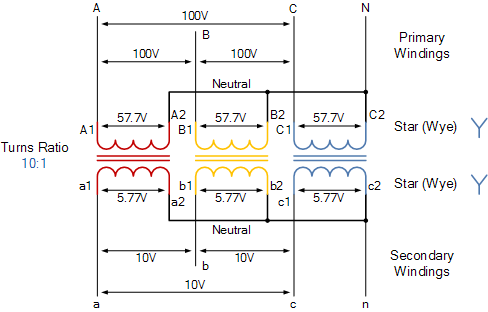Ever wondered how electricity makes its way from power plants to your home appliances? It's a journey of transformation, quite literally! At the heart of this process are ingenious devices called transformers, silently orchestrating the flow of electrical energy. They're the unsung heroes of our modern electrical grid, enabling us to power everything from tiny phone chargers to massive industrial machinery.
So, how does a transformer change voltage? The answer lies in the elegant dance of magnetism and electricity. Transformers leverage the principle of electromagnetic induction, a phenomenon discovered by Michael Faraday. This principle dictates that a changing magnetic field can induce a voltage in a nearby coil of wire. A transformer utilizes two coils, a primary and a secondary, wrapped around a shared magnetic core. By varying the number of turns in these coils, transformers can either step-up or step-down voltage levels with remarkable efficiency.
The history of voltage transformation is intertwined with the development of electricity itself. Early experiments with electromagnetism paved the way for the first practical transformers in the late 19th century. These initial transformers played a crucial role in the "War of the Currents," ultimately contributing to the widespread adoption of alternating current (AC) power systems. The ability to efficiently modify voltage levels was paramount for long-distance power transmission and distribution, making AC the dominant standard.
The importance of voltage transformation is hard to overstate. Imagine trying to transmit electricity across hundreds of miles at the low voltages used in homes. The power loss due to resistance would be astronomical! Transformers allow us to step-up voltage to extremely high levels for efficient long-distance transmission, and then step-down voltage again to safer, usable levels for our homes and businesses. This process minimizes energy waste and makes modern power grids possible.
Voltage modification is essential for ensuring compatibility between different parts of the electrical system. For example, power plants generate electricity at high voltages, typically thousands of volts. This high voltage is stepped down by transformers at substations before reaching our homes, where it's further reduced to the standard 120 volts (or 240 volts in some regions) used by most appliances.
A simple example is a doorbell transformer. It reduces the standard household voltage of 120 volts to a much lower voltage, typically 16 or 24 volts, making it safe for the low-voltage doorbell system.
Benefits of Voltage Transformation:
1. Efficient Power Transmission: Stepping up voltage reduces power loss during long-distance transmission.
2. Device Compatibility: Transformers ensure that devices receive the correct voltage for optimal operation.
3. Safety: Transformers can step down voltage to safe levels for household use.
A step-by-step guide to understanding how a transformer works involves exploring the concepts of electromagnetic induction, the relationship between the number of coil turns and voltage, and the role of the magnetic core in linking the primary and secondary coils.
Advantages and Disadvantages of High Voltage Transmission (Related to Transformer Use)
| Advantages | Disadvantages |
|---|---|
| Reduced power loss | Higher initial infrastructure costs |
| Enables long-distance transmission | Requires specialized safety measures |
Best Practices for Transformer Implementation:
1. Proper Sizing: Selecting the correct transformer capacity for the intended load.
2. Cooling: Ensuring adequate cooling for efficient operation.
3. Protection: Implementing protective devices to prevent overloads and short circuits.
4. Grounding: Proper grounding to minimize safety hazards.
5. Regular Maintenance: Periodic inspections and maintenance to ensure reliability.
FAQs about Transformers:
1. What is a transformer? A transformer is an electrical device that changes the voltage of an AC power supply.
2. How does a transformer change voltage? It uses electromagnetic induction to induce a voltage in the secondary coil based on the voltage applied to the primary coil.
3. What are the different types of transformers? Common types include step-up, step-down, and isolation transformers.
4. What is a step-up transformer? A step-up transformer increases voltage.
5. What is a step-down transformer? A step-down transformer decreases voltage.
6. What is the core of a transformer made of? The core is typically made of laminated iron or steel to minimize energy loss.
7. Why is AC used in transformers? Transformers rely on changing magnetic fields, which are naturally produced by AC.
8. What are the main applications of transformers? Transformers are used in power transmission, distribution, and electronic devices.
In conclusion, understanding how transformers change voltage is fundamental to grasping the intricacies of our modern electrical infrastructure. From the massive transformers humming in power substations to the small ones powering our everyday devices, these ingenious inventions enable the efficient and safe delivery of electrical power. The ability to modify voltage levels is a cornerstone of modern society, powering our homes, industries, and technological advancements. By continuing to refine transformer technology and optimize their implementation, we pave the way for a more sustainable and electrified future. As we delve deeper into the world of electricity, appreciating the role of transformers is essential for anyone curious about how power makes its way to our fingertips.
how does a transformer change voltage - Trees By Bike
Three Phase Transformer What Is It How Does It Work - Trees By Bike
How does a transformer change voltage or current without a change of - Trees By Bike
Schéma électrique transformateur simple - Trees By Bike
Single Phase Transformer Diagram - Trees By Bike
Connection Of Single Phase Transformer - Trees By Bike
Starter The equation for electrical power is Power Voltage x current - Trees By Bike
208v Three Phase Wiring Diagram - Trees By Bike
How To Connect Wires To A Transformer - Trees By Bike
Which of these does a transformer change voltage current energy - Trees By Bike
How does a transformer convert voltage and current - Trees By Bike
Which Of These Does A Transformer Change Voltage Current Energy Power - Trees By Bike
Current Transformer Calculation Pdf - Trees By Bike
Signal Transformer Wiring Diagram - Trees By Bike
An introduction to distribution transformers and power transformer - Trees By Bike












